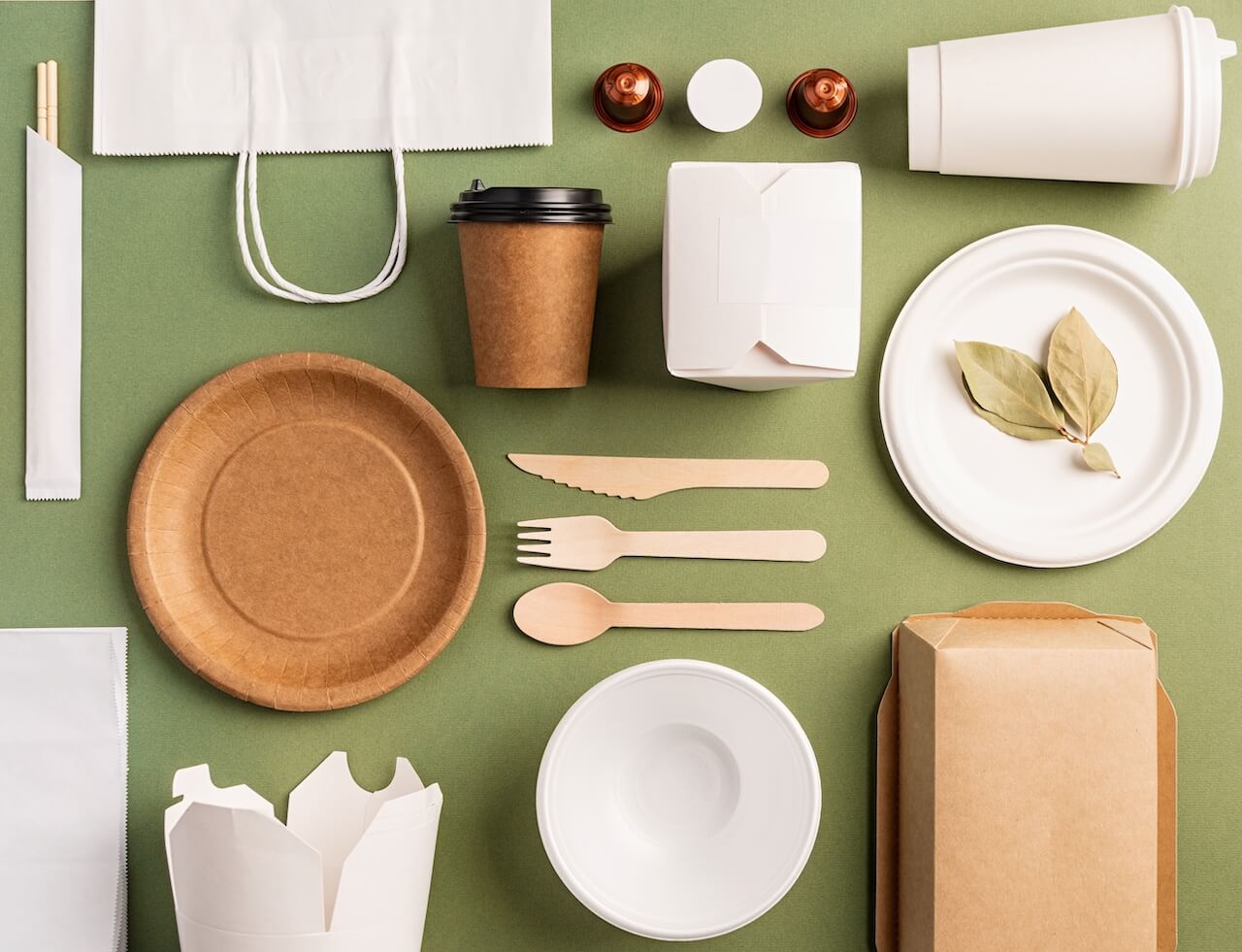
Packaging materials, often used once and discarded, are a significant source of waste and pollution. Eco-friendly alternatives present a viable solution to this global problem. Let’s explore the different types of eco-friendly materials for packaging and their attributes, providing insights into biodegradable, compostable, and recyclable options, and the differences between them.
Table of Contents
The Merriam-Webster dictionary defines eco-friendly as “not environmentally harmful”. Although there is no EU standard that would provide a definition of eco-friendly packaging materials, the European Consumer Centre France provides criteria that can be used to identify eco-friendly products:
Eco-friendly packaging materials are a boon to our planet, and come in several types:
Biodegradability is a process where the material breaks down into carbon dioxide, water and biomass over time. The process is facilitated by microorganisms and depends on the conditions (such as temperature or humidity) of the specific environment (e.g. industrial composting plant or soil), and on the material.
Biodegradable materials help reduce the volume of waste in landfills. Unlike conventional plastics, they do not contain dangerous toxins and chemicals, as they are made from natural sources.
Some materials that are misleadingly labelled as biodegradable might still leave behind small fragments or toxic residues.
Biodegradability represents a closed loop.
Compostability is a characteristic of packaging that allows it to biodegrade under particular conditions of industrial or home compost. The material must be biodegradable in order to be recovered by composting. In other words, all compostable packaging is biodegradable.
Like biodegradable packaging, compostable packaging breaks down into non-toxic components.
The difference between biodegradable and compostable materials is that compostable packaging will totally decompose and can even be used to grow more resources, as its end product, compost, can enrich soil and support plant growth. It also reduces dependence on fossil fuels.
Many compostable materials require the high temperatures of industrial composting facilities to break down effectively. If they end up in a landfill, they may not decompose fully or quickly. They can’t be recycled and can contaminate recycling streams if they’re not disposed of correctly.

Recyclable packaging, once used, can be processed to extract raw materials, which are then used to manufacture new products. It supports a circular economy, where materials are kept in use for as long as possible, reducing the need for new resources.
However, not all materials can be recycled.
Non-recyclable materials, such as biodegradable and compostable plastics, can contaminate the recycling stream if they’re mixed in.
This type of packaging is made from a material that is derived from biomass. It’s not automatically biodegradable as the ability of a material to biodegrade depends on its chemical structure and not its resource base.
It means that 100% fossil-based plastics can biodegrade, and 100% biobased plastics might not.
Biobased materials come from renewable resources, which can be regrown, unlike conventional plastics. They can also help reduce GHG emissions. On the other hand, the cultivation of crops for biobased materials can compete with food production for land use and potentially harm biodiversity if not managed sustainably.
To sum it up, biodegradable packaging breaks down into carbon dioxide, water and biomass. Compostable packaging will totally decompose and can even be used to grow more resources. Recyclable packaging can be converted into raw materials that can be utilized to generate new products. Finally, biobased packaging is derived from biomass but is not necessarily biodegradable.
Eco-friendly materials are made from renewable resources and are often recyclable, biodegradable, or compostable. Here are some examples:
Bioplastics are made from plants (e. g. corn, sugar cane, and sugar beet) or other biological materials (such as bacteria’s byproduct). They are a diverse family of materials divided into three main groups:
They reduce dependence on fossil fuels and emit fewer greenhouse gases compared to conventional plastics. According to existing research, using biobased polymers to replace roughly 67% of the world’s plastic use could potentially save 241–316 Mt of CO2 eq. annually.
Today, bioplastics can have the same qualities and offer the same packaging quality as traditional plastics. They can offer heat resistance, hardness, flexibility, plus special properties beneficial for the planet, such as biodegradability or compostability. An example is NonOilen®, a bioplastic that offers, among other qualities, flexibility and rigidity at higher temperatures.

The need for specific composting facilities to break them down effectively is a potential drawback. The more conventional solutions require closed-loop systems like having a canteen that is able to collect all of the cups and cutlery it uses, and then place them in composters intended for the disposal of kitchen and food waste.
Such solutions also require education to the public to establish better composting routines for bioplastics, as well as new and better regulation. NonOilen®, on the contrary, can decompose in the soil, and it therefore avoids polluting the environment even if it’s not composted properly.
Recycled paper, a well-known eco-friendly material, lessens deforestation by reducing the need for virgin wood pulp. It also saves energy and water in production compared to the new paper. Nonetheless, the process of recycling paper still requires significant energy, and the quality of paper may degrade after repeated recycling.

Mushroom-based packaging is a novel, biodegradable and completely compostable material. It’s made from mycelium, the root structure of mushrooms. It offers robustness and versatility in use and helps in waste reduction as it’s grown using agricultural waste. On the downside, it’s a relatively new concept, and production scalability and consumer acceptance may pose challenges.
Seaweed packaging is entirely biodegradable. Seaweeds don’t require the use of pesticides or a lot of space to grow quickly, making it an exceptionally sustainable choice. While promising, its unfamiliarity to consumers and potential smell and texture issues may affect its wide-scale adoption.
Cellulose packaging, made from plant fibres, is both recyclable and compostable. It's a versatile material used in a range of products, from bags to food wraps. Nevertheless, the energy-intensive production process can be a con, and it is important to ensure that the cellulose comes from sustainable forestry.
The market offers many eco-friendly alternatives to conventional plastics. Whether through the use of biodegradable, compostable, recyclable, or biobased materials or novel materials like bioplastics or seaweed-based packaging, you can significantly decrease the environmental footprint of your business.
If you’re looking for practical steps that can help you transition to eco-friendly packaging materials, make sure to read our guide for business owners.